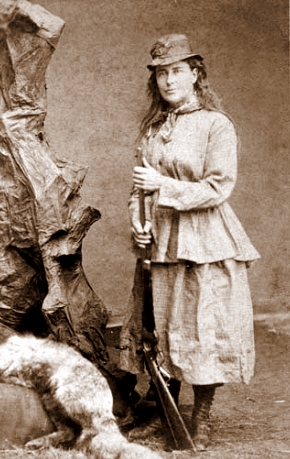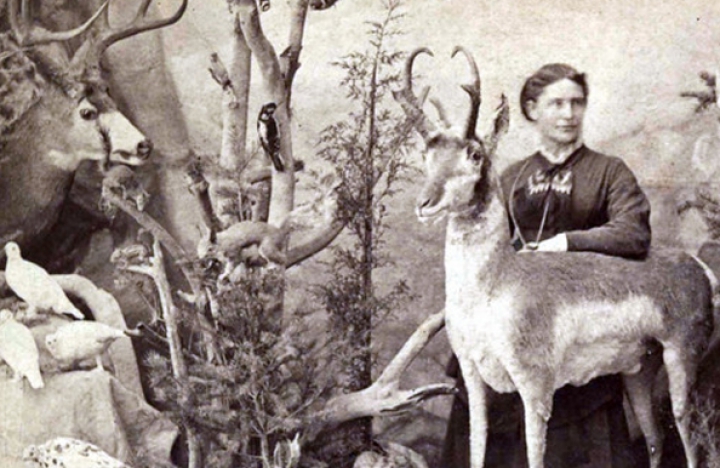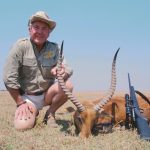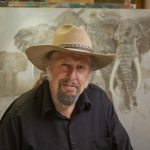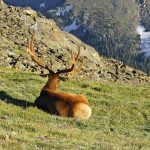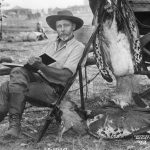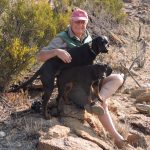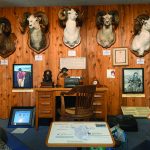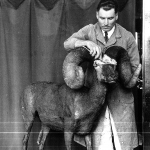Martha Maxwell left a legacy as one of America’s most influential taxidermists.
While wandering around the fascinating Cowgirls of the West museum in downtown Cheyenne, Wyoming, recently, I came across a photo that stopped me in my tracks. The blurry black-and-white image showed a display of mounted mule deer, elk, pronghorn, and bighorn sheep to rival any trophy room in the Great Hunters books, all of them arrayed in natural-looking habitats. Next to this photo was a studio shot of the taxidermist who had created the display—an intrepid-looking woman leaning on a rifle, a hound at her feet. Reading the accompanying text, I learned that the taxidermy display was featured at the 1876 Centennial Exposition in Philadelphia, and was one of the most popular exhibits at the international fair. The woman’s name was Martha Maxwell, and she was, like me, a native Pennsylvanian who ended up living and hunting in Colorado. Intrigued, I set out to learn more about her.
Born Martha Dartt in 1831 in Tioga County, Pennsylvania, Martha developed an appreciation for the natural world from traipsing the hills of northern Pennsylvania with her grandmother. Her family ended up in Baraboo, Wisconsin, and in 1854 she married James Maxwell, a local businessman twenty years her senior with six children. In 1857 they had a daughter of their own, named Mabel. Around the time Mabel was born, James apparently lost everything in the Panic of 1857. Looking for a new start, the couple headed west, joining the Pikes Peak Gold Rush. They left Mabel with Martha’s family in Baraboo, and arrived in the Colorado Territory in 1860, settling in Nevadaville.
Like most of the hopefuls who staked a mining claim, James failed to strike it rich. Martha was smarter, making money off the miners themselves, first by doing washing and other chores, and later opening a boardinghouse. She invested the money she earned, and bought a cabin on the plains east of Denver. Legend has it when the couple attempted to move into the cabin, they found a squatter already living there. The squatter, a German, turned out to be a taxidermist, and when they booted the man out, Martha found a big collection of mounts in the cabin. This apparently sparked her desire to learn the art, and she sent away for a how-to book on the subject.
In 1862 Martha returned to Wisconsin to take care of her daughter and ailing mother, and while there she continued her study of taxidermy. She returned to Colorado in 1867 at the behest of her husband, and that’s when she got into serious hunting and collecting. She began taking extended hunting trips into the Rockies, starting out with small animals such as chipmunks and hawks, and later taking a great many species of big game, including bison, elk, and pronghorn. Within a year or so she had more than 100 specimens, and received an invitation to exhibit them at the 1868 Colorado Agricultural Society exhibition. She surrounded each animal with its realistic natural habitat; she has been credited as the first taxidermist to do so. Her display was a hit and she won a $50 prize.
A few years later, in an attempt to turn her hobby into a moneymaking career, Martha opened her own museum in Boulder, where animals including a bear, a mountain lion, and a bison were on display, surrounded by her signature elaborate habitats. In 1875 she moved the museum to Denver, where she hoped to attract more visitors.
By then, Martha had become an expert taxidermist. She developed a number of new techniques, experimenting with plaster molds and iron frames over which she stretched preserved skins. Most taxidermists of the day were simply sewing skins together and then stuffing them with filler, which led to some horrible-looking mounts.
Martha was also an expert naturalist, and she kept up a correspondence with biologists at the Smithsonian. She sent them the first black-footed ferret they had ever seen; the animal had been described by explorers, but Martha was the first to mount one. She also discovered and described the western subspecies of the screech owl, which was subsequently named Otus asio maxwelliae (Mrs. Maxwell’s owl).
In 1876, the Territory of Colorado sent Martha to Philadelphia for the Centennial Exposition. She created a complex diorama that included numerous species she had hunted and mounted. She placed plains species and mountain species in their appropriate habitats and posed them at representative elevations. Her display even included small live mammals, including prairie dogs. The display was a huge hit—most Easterners had never seen Western animals or Western habitats, and Martha’s display immersed them in both.
Apparently some visitors were skeptical. “How could a woman do it?” “Did she kill ’em all?” “What sort of a woman is she?” were some of the questions that bombarded Martha’s half-sister Mary Dartt, who was helping out at the expo. Annoyed, Mary put up a sign that read, “Woman’s Work” and assured visitors that yes, Martha had done all the hunting and taxidermy work that went into the display. Between May and November 1876, the expo attracted some 9.8 million visitors.
Unfortunately the “Colorado Huntress,” as Martha was known by then, never returned to Colorado. Estranged from her husband and unable to make her various attempts at museums financially successful, she moved to Rockaway Beach, New York. By this time she was suffering from cancer, which was apparently not unusual for early taxidermists as a result of their work with potent chemicals. Martha died in 1881, having left a legacy that later influenced America’s greatest taxidermists, including Carl Akeley and William Hornaday.
